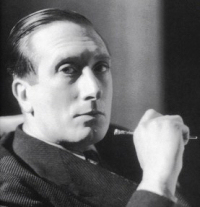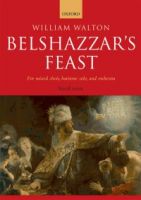Walton Belshazzar
 Vocal Scores for Walton's Belshazzar's Feast
Vocal Scores for Walton's Belshazzar's Feast
The OUP edition of Walton's Belshazzar's Feast is for SATB

Catalogue Number:OUP3359543
ISBN:9780193359543
Please click here if you wish to order and further vocal score information
Please order by 3pm to be despatched today




Belshazzar's Feast is a cantata by the English composer William Walton. It was first performed at the Leeds Festival on 8 October 1931. The work has remained one of Walton's most celebrated compositions and one of the most popular works in the English choral repertoire. Osbert Sitwell selected the text from the Bible, primarily the Book of Daniel, and Psalm 137 (By the waters of Babylon). The work is dedicated to Walton's friend and benefactor, Gerald Berners.
In the story of Belshazzar's Feast, the Jews are in exile in Babylon. After a feast at which Belshazzar, the Babylonian king, commits sacrilege by using the Jews' sacred vessels to praise the heathen gods, he is miraculously killed, the kingdom falls, and the Jews regain their freedom.
Although they are not specified in the published score, there is a clear delineation between sections, as follows:
1. Thus spake Isaiah
2. If I forget thee O Jerusalem
3. Babylon was a great city
4. In Babylon, Belshazzar the King made a great feast
5. Praise ye
6. Thus in Babylon, the mighty city
7. And in that same hour
8. Then sing aloud to God our strength
9. The trumpeters and pipers were silent
10. Then sing aloud to God our strength
The music throughout is strongly rhythmic, and richly orchestrated. The rhythms and harmonies reflect Walton’s interest in jazz and other popular music, pressed into service to tell a religious story. Despite its jagged rhythms and strident orchestral effects, the work is essentially conventional in its tonality. Walton's biographer Michael Kennedy writes, "diatonicism is at the root of the matter ... string tremolandi, brass fanfares, and masterly use of unaccompanied declaration work their customary spell." Kennedy adds that the chilling orchestral sounds which introduce the writing on the wall derive from Richard Strauss's Salome.
The cantata is in ten distinct sections, played continuously. After a brief, recited introduction, the chorus and baritone sing of their homeland Zion, in an emotional setting of Psalm 137 (By the waters of Babylon, there we sat down, and wept), and angrily express their bitterness toward their captors. The narrative then begins, and in a prolonged sequence we hear their horror, and then outrage, at the profanities of the king, followed by an exuberant march section depicting the king and his court praising their gods. The section is framed by a descending figure of four notes that, through repetition, passes down through the orchestra, immediately establishing a jazz influence with a flattened first note and marked syncopation.
This leads to an eerie, and economically orchestrated, depiction of the writing on the wall, and the death that night of Belshazzar (the story of Daniel interpreting the writing is omitted). The people celebrate their freedom, in a joyous song of praise interrupted by a lament over the fall of a great city (derived from Psalm 81 and the Book of Revelation).
The chorus represents the Jewish people throughout, although they adopt the tone of the Babylonians when telling the story of the feast. The baritone soloist has the role of narrator.
Walton struggled with the setting for several years, and it grew from its original conception as a short work for small forces, as commissioned by the BBC, to its eventual form. Fortunately, this was an age of gifted amateur choruses, and conductors and institutions dedicated to bringing forward new music, and the Leeds Festival took on the first performance.
At first the work seemed avant-garde because of its extrovert writing and musical complexity; it is however always firmly tonal although it is scored without a key signature and with many accidentals. The addition of the brass bands was suggested by the festival director, the conductor Sir Thomas Beecham; the bands were on hand anyway for a performance of Berlioz’s Requiem, and Beecham said to the young Walton: "As you’ll never hear the thing again, my boy, why not throw in a couple of brass bands?". However, under the baton of Malcolm Sargent, an outstanding choral conductor, it was an immediate success, despite its severe challenges to the chorus.
The London première was conducted by Adrian Boult in November 1931. The work was performed at the ISCM Festival in Amsterdam in 1933. Sargent regularly programmed it throughout the rest of his career, and took it as far afield as Australia, Brussels, Vienna and Boston. Not only British conductors from Sargent to Simon Rattle, but also Eugene Ormandy, Maurice Abravanel, André Previn, Robert Shaw, Leonard Slatkin and Andrew Litton have recorded the work. In 1947 Herbert von Karajan called it "the best choral music that's been written in the last 50 years".
It may have been partly because of The Times's first review that, despite an impeccably biblical text, Belshazzar’s Feast was not at first accepted by the Church of England as a work suitable for performance in cathedrals. It was banned from the Three Choirs Festival until 1957. The Times reviewer urged such a ban; though calling Belshazzar's Feast "a work of intense energy and complete sincerity", he declared the work, "stark Judaism from first to last", adding, "it cumulates in ecstatic gloating over the fallen enemy, the utter negation of Christianity ... no more a 'sacred' oratorio than is Handel's on the same subject." Some have maintained that Walton saw no moral distinction between the Jews and the Babylonians, as the music for both groups is equally exuberant. However, a distinction can be found in the words. Although there is an early sequence where the Jews vow revenge in particularly violent terms, their eventual victory is conveyed in praise and thanksgiving, the words "Alleluia, for great Babylon’s fallen" mixed with regret "while the kings of the earth weep, wail" for the fallen city.
Walton revised the work in 1948. Sargent conducted the premiere of the revised score at the Royal Albert Hall, London, on 8 March 1950.
Walton did not take his work with the greatest seriousness. He called the baritone solo about the wealth of Babylon (#3 above) "the shopping list" and at a Hoffnung festival concert, he conducted a large choir and orchestra in "an excerpt from Belshazzar's Feast": Walton raised his baton, and the chorus bellowed the single word "slain" (from #7). He then put down his baton, shook hands with the baritone soloist, who had not sung a note, and they both bowed and left the platform to gales of applause.
For further information of Walton's Belshazzar's Feast, please click here to visit the Wikipedia website




ChoraLine 'Voice Part' Rehearsal CDs & EasyPlay (Stream & Download)
Quick and Easy way to memorise your vocal line and practise between choir rehearsals

Know Your Notes Perfectly
Enhance Your Enjoyment when Singing
Learn With The Music
Shine In Your Choir
Sing With Confidence
Please click here to hear a ChoraLine sample for Belshazzar's Feast




If you wish to have a CD of Belshazzar's Feast to hear the whole work please click here and please do click on the video below to listen right away if you wish.




